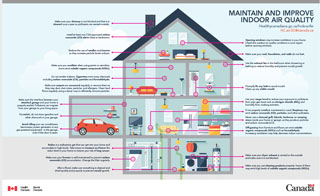Infographic: Maintain and improve indoor air quality

Download the alternative format
(PDF format, 2 MB, 2 pages)
Organization: Health Canada
Published: 2015
Make sure your chimney is not blocked and that it is cleaned once a year so pollutants are vented outside.
Install at least one CSA-approved carbon monoxide (CO) alarm close to bedrooms.
Reduce the use of candles and incense as they increase particle levels indoors.
Make sure you ventilate when using paint or varnishes. Some emit volatile organic compounds (VOCs).
Do not smoke indoors. Cigarettes emit many chemicals including carbon monoxide (CO), particles, and formaldehyde.
Make sure carpets are vacuumed regularly or remove them as they trap dust, dust mites, particles, and allergens. Clean hard floors regularly using a damp mop to efficiently remove particles.
Make sure the interface between your attached garage and your home is properly sealed. Pollutants can migrate from your garage to you living space.
If possible, do not store gasoline and other chemicals in your garage.
Avoid idling your car, snowblower, lawnmower, power generator or any gas-powered equipment in the garage, even if the door is open.
Radon is a radioactive gas that can get into your home and accumulate to high levels. Take action to measure and lower the radon level in your home to reduce your risk of lung cancer.
Make sure your furnace is well-maintained to prevent carbon monoxide (CO) accumulation. Change filter regularly.
After a flood, make sure everything is cleaned and dried quickly and properly to prevent mould growth.
Opening windows may increase ventilation in your home. Check the outdoor air quality conditions in your region before opening windows.
Make sure your roof, foundation, and walls do not leak.
Use the exhaust fan in the bathroom when showering or bathing to reduce humidity and prevent mould growth.
Promptly fix any leak to avoid mould. Clean up any visible mould.
Use your range hood to reduce your exposure to pollutants from your gas stove such as nitrogen dioxide (NO2) and humidity from cooking activities.
If not properly installed, maintained or used, fireplaces may emit carbon monoxide (CO), particles, and other pollutants.
Never use a charcoal grill, hibachi, barbecue or camping stove inside your home or garage, as they produce particles and carbon monoxide (CO).
Off-gassing from furniture and floors can emit volatile organic compounds (VOCs) such as formaldehyde. Increasing ventilation may help decrease indoor concentrations.
Make sure your dryer exhaust is vented to the outside and make sure it is not blocked.
Make sure you use cleaning products properly. Some of them may emit high levels of volatile organic compounds (VOCs).
For more information:
Healthycanadians.gc.ca/indoorair
air@hc-sc.gc.ca